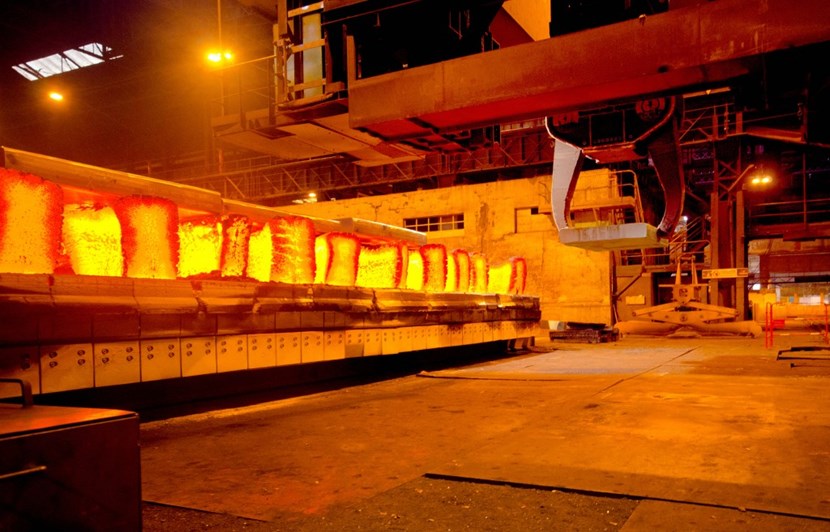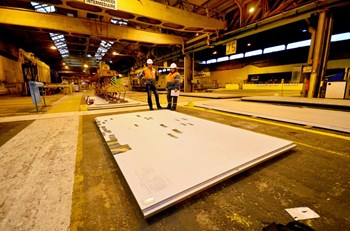How would you like your steel? Laced with a bit of titanium, niobium or molybdenum for better resistance to corrosion? With as little ferrite as possible in order to be permeable to magnetic fields? Or with added boron for better neutron absorption?
At the Industeel-Le Creusot plant in central France, a business unit of the global giant Arcelor-Mittal, steel plates comes in all thicknesses and grades. The steelworks, which was founded in 1836, has evolved into a world-class leader for special, high performance and "niche" steels—precisely the kind that ITER needs.

In the din and heat of the hot rolling mill at Industeel-Le Creusot, in central France, steel ingots are transformed into plates that will be shipped to industries in Korea, India, Russia and Europe. The plant has already booked some 10,000 tonnes of steel plates for ITER.
Steel is basically an alloy of iron and carbon. But production has come a long way since the first industrial foundries were established in the 19th century. At Industeel-Le Creusot some 450 different grades are available, reflecting international and domestic standards, and the chemical composition of each one can be tweaked to meet the specific needs of the customer.
Out of the mill, off to Korea
It is a rare opportunity to witness the early stages of the birth of an ITER component. In the din and heat of the hot rolling mill at Le Creusot, a lifting clamp seizes a seven-ton steel ingot and transfers it to a waiting conveyor bed of large glowing firebricks where seven similar ingots are waiting. As soon as this last ingot is positioned, the conveyor-bed moves swiftly into the furnace. The ingots will remain there for some ten hours, exposed to a temperature of close to 1,200 °C until they are soft enough to be rolled into 40-millimetre plates. Once properly cut, shot blasted and pickled, the plates will be shipped to Hyundai Heavy Industries in Korea, where they will be shaped into vacuum vessel segments.
"Our job is to adapt our formulas accordingly," explains Nathalie Mottu-Bellier, an engineer at Industeel-Le Creusot. "It's all a matter of chemistry..."
From the first mockups and prototypes for the ITER vacuum vessel produced in 2004 to present orders from the industries in Korea, India, Russia and Europe for ITER, the steelworks in Le Creusot has booked some 10,000 tonnes of steel plates in a dozen different grades and ranging in thickness from 5 to 150 millimetres. "Such a large tonnage for a single project is quite exceptional," emphasizes Nathalie. "The grades of steel we're providing are clearly the top of our line of production."
Components in the ITER machine (and oftentimes parts within the components) must meet various functional, safety and technological requirements. Some are exposed to the ultra-hot plasma and high vacuum, others to the extreme cold of the cryogenic fluid; some must be completely permeable to magnetic fields, others, on the contrary, must act to influence them...
The required steel quality is achieved through the subtle dosage of various elements (such as boron, chrome, nickel, niobium, molybdenum, etc.) and through particular manufacturing processes.
Steel manufacturing often resembles the elaboration of a sophisticated perfume, where fragrances combine to realize the desired effect. In French, the steelmakers use the word "nuance" to characterize the different grades they produce.
Chemistry is a key element, but in some cases the manufacturing process can also be crucial. "The Korean company SFA Engineering Corp, who's procuring the thermal shield system, will add a thin layer of silver to the plates that we supply," explains Jean-Christophe Gagnepain, the sales manager at Industeel-Le Creusot. "The quality of this layer depends on the quality of the plate's surface, and ultimately on our production expertise."

These steel plates, ready to be shipped to Korea, are for the ITER thermal shield.
Industeel-Le Creusot has already shipped 5,000 tonnes of stainless steel plates to India (half of it destined for the ITER cryostat), 3,500 tonnes each to Japan and Korea, and 300 tonnes to Russia. The "steel jewellers" as they dub themselves, are also recyclers: as steel has the particularity of being indefinitely recyclable, all the plates produced at Le Creusot comes from steel scrap, trimmings and cut-offs from, among others, the automotive and construction industries.
In a rural area of central France, a steelworks founded in the early years of the 19th century is helping to meet the challenges of one of the most complex machines of the 21st.
More images of the ongoing works at Industeel-Le Creusot here.








